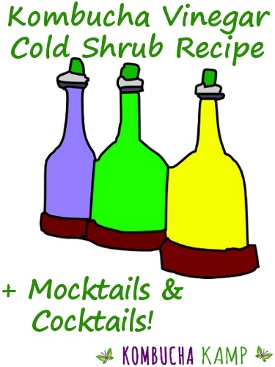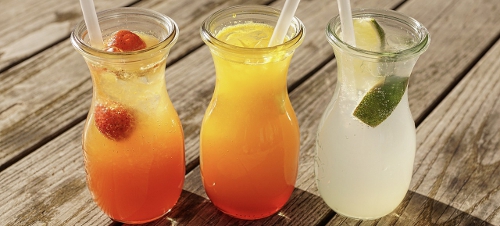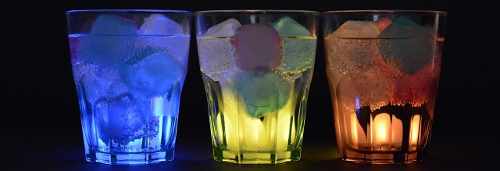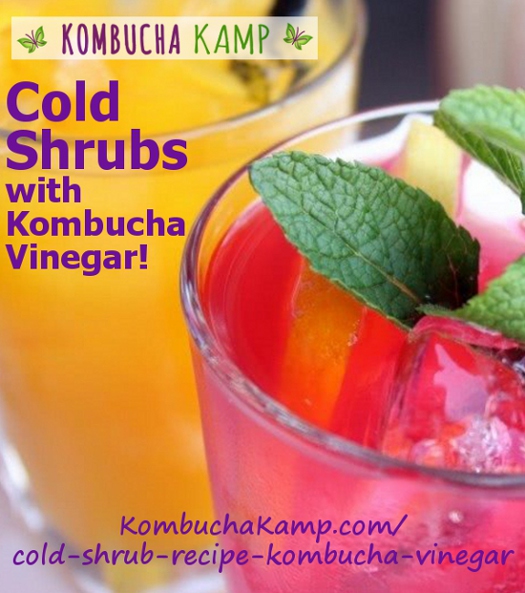
Fermented Cold Shrub Recipe made with Kombucha Vinegar plus Kocktails & Mocktails
 Shrubs (beyond being attractive landscaping) are a sweetened fruit syrup preserved in vinegar. Refreshing and delicious, this cold shrub recipe has delighted humankind since ancient times. Shrubbing was a crucial process to ensure that vital nutrients such as vitamin C were available throughout the leaner winter months or on long voyages across the sea.
Shrubs (beyond being attractive landscaping) are a sweetened fruit syrup preserved in vinegar. Refreshing and delicious, this cold shrub recipe has delighted humankind since ancient times. Shrubbing was a crucial process to ensure that vital nutrients such as vitamin C were available throughout the leaner winter months or on long voyages across the sea.
During Prohibition, shrubs became a popular alcohol substitute. The modern “farm-to-bar” cocktail movement made them hip again. Whenever the whistle desires whetting, shrubs offer a tangy, refreshing option, whether added to a cocktail or just a plain glass of water.
Using kombucha instead of vinegar adds another layer of flavor and bacteria and yeast buddies. The cold shrub recipe process means our little friends stay alive and active. These tasty and easy-to-make syrups are sure to become family favorites, whether they’re destined for homemade sodas or for cocktails. Check out all the options below!
The typical cold shrub recipe follows a standard ratio of 1 part fruit:1 part sugar:1 part vinegar. However, since kombucha vinegar is less acidic than traditional vinegars, the ratio for a Kombucha shrub is 1 part fruit:1 part sugar:2 parts kombucha vinegar. Any type of fresh fruit works — try berries, peaches, plums, rhubarb, apricots, apples, melons, cherries; you name it!
Kombucha vinegar yields the best flavor, but unflavored Kombucha can also be used as it will continue to ferment, even in the fridge. Flavored Kombucha or Kombucha Vinegar can add a layer of complexity to the final shrub.


To Make a Kombucha Shrub, You’re Going To Need Kombucha Vinegar
Nearly any old Kombucha, meaning Kombucha that has been fermenting for a long time (even from a SCOBY Hotel), might be considered “vinegar” due to the sour taste on the tongue. But sour Kombucha may only contain up to about 1% acids, which is tame when compared to traditional vinegars that generally have around 5% acids. Gradually adding the sugar prevents the brew from becoming overwhelmed, instead spurring the natural processes repeatedly until the acids have built up to a more powerful 2-3%. Even still, this leaves Kombucha Vinegar about half as strong as traditional vinegar, which is why we use twice as much for this recipe.
Kombucha Vinegar Recipe
The following is an excerpt from The Big Book of Kombucha pg 256 (Copyright Storey Publishing 2016). We recommend making Kombucha Vinegar in half gallon or larger batches so you have plenty on hand for shrubs, salad dressings, marinades and the like.
“To make kombucha vinegar, start with a batch of kombucha (1 gallon or less) that is already at least four weeks old; it should have about 1 percent acidity at that point.
To increase the acidity of the vinegar to 2 percent, add 2 teaspoons of sugar per pint of vinegar every two weeks for a period of six weeks (that’s three rounds total). More rounds can be added as desired. Use immediately or flavor with herbs and ferment for up to six months, depending on how strong you like your vinegar. A SCOBY may form; you can either ignore it or remove it.
Because it has a relatively mild acetic-acid profile, kombucha vinegar tends to be less tart than other vinegars. When you’re cooking with it, if you prefer a stronger vinegar flavor you can increase the amount of kombucha vinegar or supplement with another, more tart vinegar such as balsamic or apple cider.”
Cold Shrub Recipe
Yield 3 cups
And now on to the Shrubbing! The sugar and acid help to break everything down, releasing the natural sugars from the fruit. The vinegar and sugar mix with all the natural flavors to create a sweet, sour treat. Both sugar and vinegar are preservatives, so the resulting product from this cold shrub recipe will have a long shelf life.
- 1 cup fruit, chopped and pitted
- 1 cup sugar
- 2 cups Kombucha vinegar
INSTRUCTIONS
- Place fruit and sugar into a non-reactive container and toss gently to combine. If the fruit is more fibrous, use a kraut pounder or potato masher to muddle the fruit and sugar to release more juices.
- Store covered at room temperature for 24 hours. After a few hours, the sugar will pull liquid from the fruit creating a sweet syrup. Stir occasionally to redistribute the sugar over the fruit.
- After 24-36 hours, strain the fruit through a sieve or piece of cheesecloth, pressing to release as much juice as possible from the solids.
- Scrape any sugar bits left in the container into the syrup.
- Add the Kombucha vinegar and stir to dissolve any residual sugar.
- Pour the mixture into clean bottles or jars and shake again before storing in the fridge.
- Shake prior to use to distribute the sugar evenly in the shrub.
The sugar may recrystallize on the bottom of the bottle when left undisturbed for an extended period of time. If that happens, shake well to re-dissolve the sugar in the liquid. Over time the acids in the vinegar and fruit will fully dissolve all of the sugar crystals. Taste shrubs frequently. They do mellow in the fridge, so frequent tasting will allow you to observe how the flavor changes over time. Shrubs keep for 2 months or longer but toss if any mold is detected.
Now that you have a reliable basic cold shrub recipe to work from, here’s a couple of flavor possibilities to try. Make whatever type of shrub you think you will enjoy, there’s no wrong combination!
Beet Lemon Kombucha Vinegar Shrub
INGREDIENTS
- 1 cup beets, sliced
- ¼ cup lemons, sliced – peels intact
Lemon Lavender Kombucha Vinegar Shrub
INGREDIENTS
- 1 cup lemons, sliced – peels intact
- ¼ cup of lavender flowers & leaves
Kombucha Shrub Mocktails or Kocktails
Now that you have the technique for making shrubs, let your imagination run wild and craft whatever flavor you like. Using those shrubs to make delicious mocktails and kocktails is the final step. Again, the options are unlimited, so pick your favorite drink and make your own best version! Here are just a couple of ideas to get you going, using the shrubs we already made. 🙂


Sangria Sangre
The jewel tones of the Beet Lemon Shrub and red grape juice give this “bloody” beverage its signature rich hue while imbuing real blood boosting properties. You can also make a larger batch (scale the recipe x4 or x8 to make a half or full pitcher to share with friends!) and allow the fruit to soak overnight for an authentic sangria experience.
BY THE GLASS INGREDIENTS
- 4 ounces Beet Lemon Kombucha Shrub
- 4 ounces Red or White Grape Juice (substitute wine for Kocktails)
- Splash of sparkling water (THRIVE, AMZ)
- ⅛ cup of apples, pears or other crisp fruit, diced
- 1 Orange Wheel
INSTRUCTIONS
- In a tall glass, add fruit pieces then top with shrub and juice.
- Add a splash of sparkling water for fizz.
- Garnish with an orange wheel.
LavendeRita
The soothing properties of lavender combine with the palate cleansing power of lemon to create a drink so satisfying you won’t even notice its non-alcoholic.
INGREDIENTS
- 4 ounces Lemon Lavender Kombucha Shrub
- 2 ounces sparkling water (THRIVE, AMZ)(substitute tequila or rum for Kocktail)
- Salt (THRIVE, AMZ) & sugar, for rim
- Lavender bud
INSTRUCTIONS
- Rim a martini or rocks glass with a combination of sea salt and sugar.
- Add ice, shrub, and water (or alcohol) to shaker, mix and pour into glass.
- Garnish with lavender bud.




Marja Voges
September 23, 2022 at 8:16 pmHi, Hannah,
Have been brewing Jun in continuous brew method. How do I change the Jun to Kombucha, which I think I prefer.
Thank you, rgds
Marja
Anthea Tayag
September 28, 2022 at 12:47 pmWhile it is possible to transition a Jun SCOBY to brew Kombucha, the SCOBY may not be healthy in the long run. It may take several tries for the culture to acclimate to its new brewing situation or may go to mold. If you wish to try it out, you may follow our Kombucha Recipe and use a spare Jun SCOBY. https://www.kombuchakamp.com/kombucha-recipe
Maria
June 12, 2021 at 6:04 pmHi Hanna, what can I do with all my milk keifer that has gotten so big? My refrigerator has lot of jars with grains covered with milk and sugar, for storage. Should I just eat them or what? Also if I drain off the milk it’s been stored in for three to four or more weeks can you still drink it too or not.?
Maria
Hannah Crum
June 27, 2021 at 1:29 pmYes, you can eat them, blend into smoothies, compost, share with friends, give to pets, etc.
Christina
March 15, 2021 at 2:44 pmHi,
I got your book (which I am enjoying VERY much) and read about making the vinegar. I’m a little confused. Could you please walk me through a few things I’m not understanding?
1. Does the vinegar come about from the first ferment or do I process it as a second ferment and, during the second ferment, it becomes the vinegar (feeding it the sugar per the book’s directions)?
2. If a SCOBY forms, may I use it for a future brew or use it in a jerky or fruit leather recipe found in the book?
Thanks for your time and help,
Christina
Hannah Crum
April 2, 2021 at 6:01 pmWe consider it “Kombucha Vinegar” (KV) once its too sour to drink. That can be the result of a primary fermentation that has gone too long or we can increase the acidity by following the steps outlined in the book – both work.
Yes! Use the SCOBYs for jerky, face mask, compost, and more!
Robbin Klein
May 6, 2019 at 11:55 amhi all,
question regarding brewing kombucha vinegar: Should the brewing happen under normal breathable cover or air tight seal. Currently keeping the process under a breathable cover until i find out otherwise. Afraid of too much pressure from too frisky yeast and an epic geyser. Couldn’t find in your book and didn’t want to assume. Thanks for your help, Robbin
Hannah Crum
May 8, 2019 at 7:39 amAfter one stinky hotel experience, we realized that the cultures do best when a SCOBY is the lid and we use the cloth cover to prevent bugs or debris from getting into the jar. Closed tops will restrict oxygen flow which can lead to sick, smelly yeast. It can typically be recovered by exposing the jar to oxygen and the yeast will gradually rebalance. You are on the right track with the cloth cover!